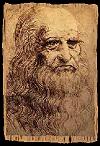|
The Codex Madrid shed a great deal of light on Leonardo's fascination with clocks. This is not surprising considering he lived during a period when clocks were being greatly improved, and those used were often of massive size presenting interesting challenges to the engineer.
It was just prior to Leonardo's time that clock makers first started to explore using springs as an alternative to weights for powering clocks. They developed the fusee to keep the force of the spring even as it wound down and this was usually controlled by gut or chain. The down side of this was the tendency for these items to stretch or break, making them unreliable. Leonardo worked on a clock spring equalizer (refer thumbnails), but no one has ever tested his ideas, so whether or not it would have worked remains unknown. Leonardo not only drew all the parts of clocks, he used diamonds and semi-precious stones in his mechanisms. He even invented and used an alarm clock in which water flowed in a thin stream from one receptacle to another. When the second receptacle was full a system of gears and levers raised Leonardo's feet into the air. Many of Leonardo's civil machines were labour-saving devices and these included a number of cranes and devices to ease the problems of lifting. He designed two automatic release mechanisms which were kept closed by the weight of the loads. As soon as the weight was relieved by contact with the ground the hooks uncoupled. The mechanisms were drawn side-by-side with Leonardo noting that the one on the right was the better of the two as the weighted hook on the other could be jammed by coming into contact with the load. (Refer thumbnails) His twin cranes were probably designed with quarrying in mind, and they allow huge blocks of stone to be shifted quickly and with relative ease. As one crane loaded a stone block from the quarry face the other would discharge its load. The entire rig would then turn around so the process could be repeated with the second crane unloading while the first reloaded. Leonardo also designed a travelling crane which was mounted on a small trolley and balanced with guide wires. It revolved on a pivot and was well designed for lifting heavy weights without being cumbersome. This crane would have been of use in the construction of tall buildings and its design was quite sound. Most of Leonardo's machines were never built in his lifetime. Indeed, many could not have been built due to the lack of suitable parts. It is particularly interesting, therefore, that modern engineers who have built many of his designs managed to make perfect working models. The one downfall that has been observed was the use of too many, or too few, cogs and springs. Some people have suggested that this was deliberate and an attempt by Leonardo to prevent the theft of his projects, most of which were quite feasible. The majority of Leonardo's ideas were rediscovered centuries after his death. |
|


